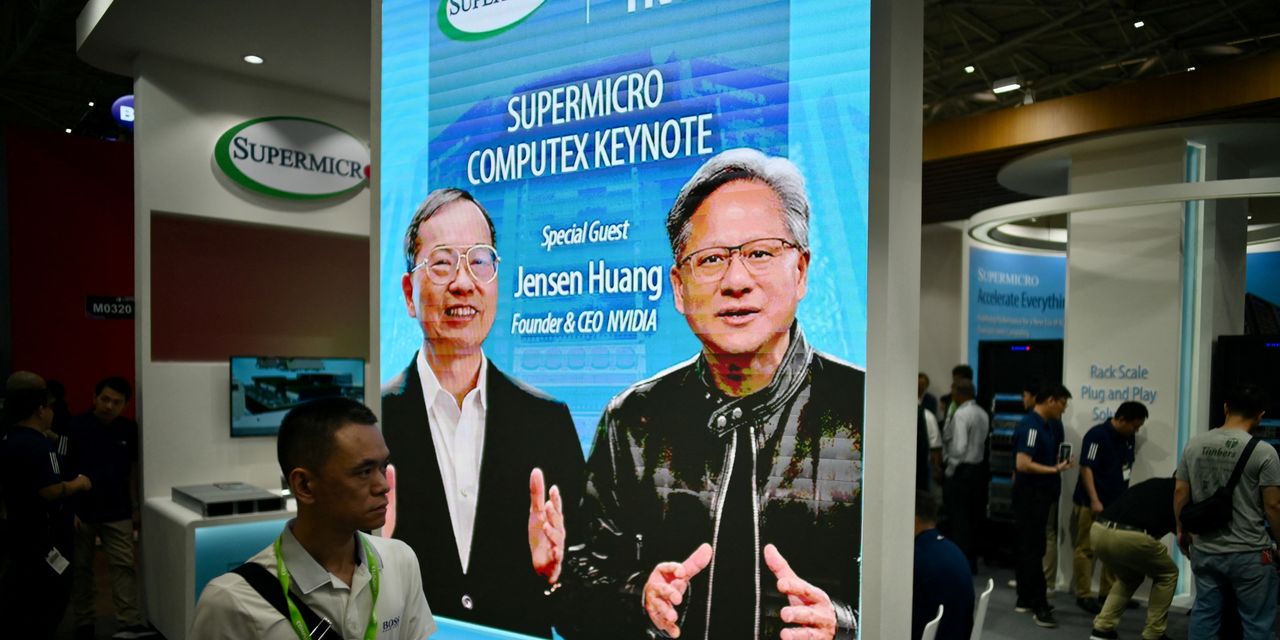Right off one of the main freeways in Silicon Valley is a cluster of non-descript, off-white buildings, some hidden by trees, with the name SuperMicro on the front.
The computer maker, officially known as Super Micro Computer Inc.
SMCI,
has a fairly large — if spread out — corporate campus, on different streets and nestled in between other tech companies. Twelve buildings are for operations, manufacturing, testing and assembly. One facility was built on Ridder Park Drive, once the site of the longtime headquarters of the San Jose Mercury News, where this columnist used to work.
While SuperMicro is not a household name like rivals Dell Technologies Inc. or Hewlett-Packard, it’s known in the Valley for its customizable servers, and works with the biggest chip makers, like Intel Corp.
INTC,
Advanced Micro Devices Inc.
AMD,
and Nvidia Corp.
NVDA,
In the past few months, SuperMicro shares have, like Nvidia’s, exploded on AI potential, rising to an all-time high of around $261.60.
Founded in 1993, the same year as Nvidia, SuperMicro is seeing its servers being purchased to run generative AI applications. Since January, its stock had soared over 200%, but its shares have fallen back slightly in recent days and it is now trading around $222. Even so, it is up over 400% from a year ago, a far cry from when it was delisted in 2018 for almost two years due to material weaknesses in its financial reporting.
“SuperMicro fits perfectly within our world view of a secular, AI-driven cycle we call the ‘Mother of All Cycles,’” said Hans Mosesmann, an analyst with Rosenblatt Securities, in a recent note initiating coverage of the company with a buy rating.
Co-founder, President and Chief Executive Charles Liang is not surprised by the recent rise in the company’s shares and market valuation. “Our stock was too low for too long,” he told MarketWatch in an interview.
He said the de-listing was due to negligence and some people not paying attention. “I just felt sorry for shareholders and employees,” he said, adding that SuperMicro always had a good foundation and good talent. It fixed its internal controls and late-filing issues raised by regulators. And since the global supply-chain crisis of the pandemic, it is also diversifying its manufacturing, building a new facility in Malaysia, for lower-cost manufacturing.
SuperMicro makes building-block solutions for the computer industry, data centers, cloud-computing services and many corporate enterprises: motherboards, servers and big racks of massive computing power. The company has also been focused on green computing for nearly 20 years, saying it’s saving its server owners hundreds of thousands of dollars a year in electricity costs. And AI servers, running generative AI and large-language models, use up even more power. SuperMicro is now offering water cooling as an option.
SuperMicro itself has had Bloom Energy fuel-cell servers at some of its buildings since 2018 for most of the energy use in its “Green Computing Park,” and Liang himself is keen on studying and planting drought-tolerant trees around the world to reduce carbon emissions, through a non-profit called the Green Earth Charitable Organization. Last year, the organization paid $12 million to acquire a nearly 200-acre ranch in nearby Milpitas, Calif., where Liang is planting more trees.
In calendar 2022, SuperMicro was the fifth-largest computer server maker, according to research company IDC, with a 5% share of the $118 billion global server market. That put it behind Dell Technologies Inc.
DELL,
; Hewlett Packard Enterprise Co.
HPE,
/New H3C Group; Inspur and Inspur Power Systems, a partnership with IBM Corp.
IBM,
; and Lenovo Group Ltd.
992,
But among that list, SuperMicro was the fastest-growing company, with 80% year-over-year growth, compared with the top maker, Dell, which grew 23%.
The company attributes that growth to its many partnerships, its ability to optimize servers for its customers, and the close relationships it has with many customers and partners in Silicon Valley, where about half of its almost 5,000 employees work.
IDC analyst Kuba Stolarski said SuperMicro is known for its customization. “Their differentiation kind of, it feels like the old Dell PC days, when you could order pretty much any configuration for a Dell PC, it was based on this huge list of options,” he said. “In today’s server market, SuperMicro is kind of in that role.” The company’s printed-out catalog, he said, was the size of a phone book, with parts and components and options. “For customers who know what configurations they need, they will go to SuperMicro,” he said. “And they can get it delivered quickly.”
“We were the first company to ship Sapphire Rapids,” Liang said, referring to Intel’s latest-generation server chip, which was beset by many delays. SuperMicro’s products often are the first to ship new central processing units (CPUs) and GPUs from Intel, AMD and Nvidia, because it is in such close proximity to its partners, with its local test and assembly centers, and therefore has shorter lead times.
“We are able to ship products earlier,” Liang said. “It may take our competitors two to four months longer.”
While SuperMicro saw nearly 60% annual revenue growth in calendar 2022, its most recent quarter disappointed Wall Street. For fiscal 2022, ended June 2022, revenue jumped 46%. In April, it warned investors of a revenue shortfall for the March-ending quarter because of component supply issues, but when it reported its results in May, the street was buoyed by guidance and its discussion of demand stemming from its servers ability to handle generative AI.
On its last earnings call, SuperMicro Chief Financial Officer David Weigand said that 29% of the company’s March quarter revenue of $1.28 billion came from AI GPU and rack-scale solutions.
“Our shipments against our record backlog may be constrained by supply-chain bottlenecks due to high demand for our advanced AI server platforms,” he told analysts. The company also said that one existing, unnamed cloud-service customer represented more than 10% of its revenue in the quarter.
What’s driving some of the bulls to the stock, however, are the company’s projections for fiscal fourth-quarter revenue growth of 6.25% to 18.75%, based on component availability, and at least 20% revenue growth for fiscal 2024. When asked about the projections at a recent Rosenblatt Technology Summit, Weigand said they were “conservative.”
“And we believe that a large portion of that will be driven by accelerated computing and large-language models. So that’s really going to drive things,” Weigand said.
The company has some doubters. Before this year’s run-up in early January, Spruce Point Capital Management, a short seller, issued a report on SuperMicro, pointing out the company’s “outlandish long-term revenue goals,” concerns about the past delisting and material weaknesses in its financial reporting. Spruce also cited its family connections with two manufacturing partners in Taiwan, which are outlined in the company’s 10-K.
“Investor enthusiasm and SMCI’s valuation have gotten well ahead of the fundamental realities that selling server hardware in our view — even with Nvidia’s AI chips — is a low-margin value proposition,” Ben Axler, founder and chief investment officer at Spruce Point, said in an email. “We are eager to see if SMCI can deliver on aggressive growth assumptions embedded into its current share price.”
Another bug was disclosed by SuperMicro itself in its fiscal 2022 annual report. The company does not have a clear succession plan, and without Liang, who is 65, it may not be able to implement its strategy in a timely manner.
“We are planning, for sure,” Liang said when asked about his succession plan. “It is very important for the company.” He did not offer further details, but added that he now likes to spend Sundays working on his non-profit, researching different species of trees, or planting trees.
Other skeptics include some Wall Street analysts, who are nervous about the company’s projections and that single customer that makes up over 10% of its revenue, which many believe to be Meta Platforms Inc.
META,
SuperMicro will not comment on the identify of this customer.
“We are wary of the magnitude of management’s growth forecasts (20% or better) particularly in light of macro pressure on SMCI’s traditional enterprise compute business, continued pessimism around new CPU product rollouts, and potentially some headwinds if the scope of the Meta business slips this year,” said Wedbush Securities analyst Matt Bryson, in a note after earnings last month.
After decades of research into artificial intelligence bore little commercial fruit, the arrival late last year of ChatGPT has breathed new life into Silicon Valley, and SuperMicro is one of those beneficiaries. Finally, 30 years after its founding, SuperMicro is getting its day in the sun. Investors will have to wait and see if it’s too much, and too soon.
Read the full article here





